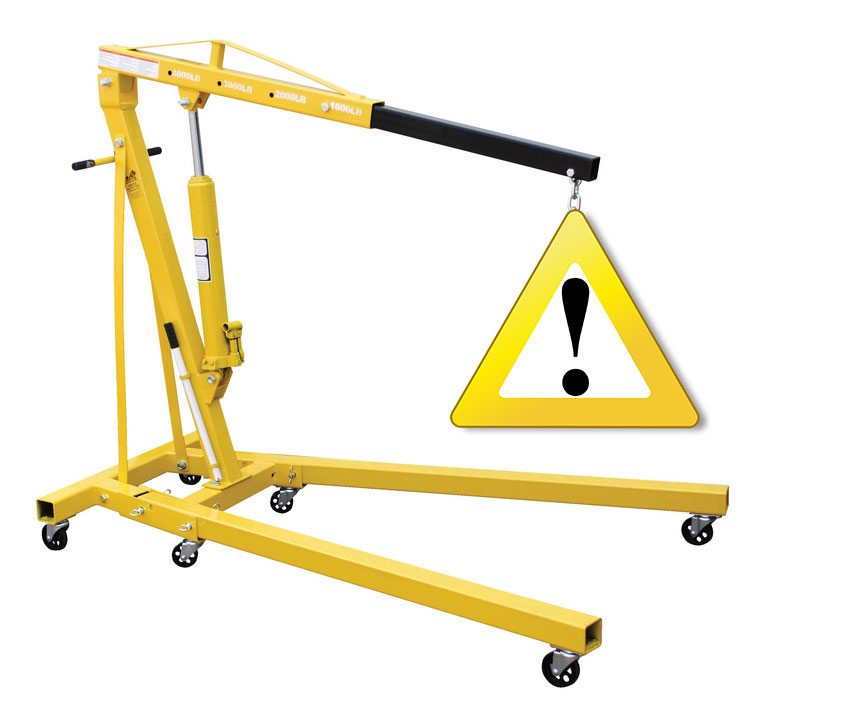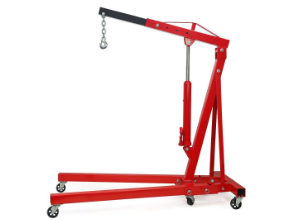Safety rules for using an engine hoist
General safety instructions
- Always read all usage and safety instructions of the hoist and make sure you understand every part of it. If something is unclear, contact the manufacturer of the hoist or ask to a certified store for help.
- Use hoist only for activities indicated by the manufacturer in hoists usage instruction.
- Hoist can be operated only by trained professionals.
- Inspect all technical aspects of an engine hoist such as the load limit, maximum and minimum lifting heights, length of adjustable boom and legs.
- Never use hoist for lifting loads heavier than allowed by the manufacturer.
- Engine lifters with adjustable boom have different allowed load limits for different adjustment positions. If boom gets extended the allowed lifting limit decreases. These limits are usually indicated on the side of the boom and in usage instructions of the hoist. Always take into account these lifting limits before lifting a load with the adjustable boom.
- Remember that a dynamic load can put a lot more weight on the lifter than a static load. Before lifting a dynamic load that can swing or wobble, count in an additional weight that the hoist will need to hold.
- Do not use an engine lifter under influence of alcohol, drugs or other intoxicants.
- If working with extremely heavy loads, make sure there is another person to help you in case of any problems or accidents.
- Use proper clothing, while working with an engine hoist. Avoid wearing lose clothes, jewelry or other type of clothing or accessories that can interfere operation with the hoist.
Assembling the tool
- Before assembling an engine hoist for the first time, identify all parts, bolts and washers, check if nothing is missing. Identify these parts by looking at the engine hoists assembling instruction. Also check if all parts of the hoist are in a proper working condition.
- Check if there is enough free space around the place, where you’re going to assemble the hoist.
- Assemble the hoist only after the instructions that came with the hoist. Usually most engine hoists need to be assembled starting with the bottom part (legs) and going up the main frame and attaching jack and the boom at the end.
- After assembling the unit, double check if all bolts, pins and washers are in the correct places and are safely strengthened.
- Test the hoist with low weight load to check if everything is working correctly before using it for lifting heavy objects like engines.
Before usage
- Read the user’s manual of the hoist before using it for the first time. Make sure you know the maximum allowed weight limits of the hoist before using it.
- Carefully inspect the engine hoist for any damage or worn out parts before each usage. If there are any damaged parts, DO NOT USE THE HOIST. Contact the manufacturer of the hoist or the closest official dealer for manufacturer certified spare parts.
- Always check the condition of the lifting chain and hook that are located at the end of the hoists boom before lifting the load. Check for any cracks or bent parts. If found, do not use the hoist and replace damaged parts. Replacement parts need to have the same or higher load capacity as replaceable parts.
- Check if all bolts and screws of the engine hoist are tightened before each usage.
- Keep the work area around you clean and organized. Make sure the floor of the place you will be lifting an engine is clean from oils or debris and hoists wheels can freely move across the floor.
- Make sure that movable parts such as casters and boom are moving freely before using the hoist.
- Know the object you are going to lift. Answer to these questions before lifting with the engine hoist?
- What is the weight of the lifting object?
- Is my engine hoist suited for lifting this object?
- Is this object dynamic and will it wobbles or swing around when lifted?
- Use the engine hoist only on a flat and a solid surface.
- Make sure there are no unwanted persons around the area you will be lifting the object, this mostly applies to children.
- Secure the car from which you are going to lift the engine to prevent any unwanted movements, while lifting the engine out of the car.
Usage
Lifting
- Make sure you have the correct service manual of the vehicle you will be operating. Locate all lifting points of the engine and make sure that hoist is suited for lifting the engine.
- If using an engine hoist with adjustable legs and boom, make sure that they are adjusted to the same position before lifting the load. This will ensure that lifting load is stable and does not start to move while being lifted.
- After attaching the hoist mount to the engine, double check all the attachment cables and bolts, if they are properly attached to the engine and tightened so that the engine can be safely lifted out of the engine bay.
- Raise the engine just a bit to see if everything in the engine bay is properly disconnected from the engine.
- Position the lifter in such height that the boom is closer to 45 degrees and not 90 degrees when engine is lifted to provide more stability and allow pushing the hoist around more easily.
Moving
- The moving of a loaded engine hoist must be done slowly and with extra caution to prevent any unwanted wobbling or swinging of the load.
- Never leave an engine or other heavy load hanging on an engine hoist. Engine hoists are designed for lifting purpose only and are not intended to hold heavy loads for longer period of time. Engine must be lowered immediately after it has been moved away from the car. Engine can be stored on the ground, on an engine stand or on another specific stand made for storing heavy objects.
- Do not go under the engine or the hoist while moving it. There are many parts involved in holding the heavy load and there is always a possibility that any of these parts can fail, which can be dangerous for a person operating the hoist.
Lowering
- Immediately after moving the loaded hoist away from the car, lower the hoists boom with the engine on the ground or place it on an engine stand.
- The lowering of the engine must be done slowly and carefully, turn the bleed valve a little bit at a time. Rapid lowering may cause the engine to start moving and add unnecessary load to the hoist.
- Before removing the lifting chains and bolts from the hoist, make sure the engine is properly secured in on the ground or is strongly attached to the engine stand.
Maintenance
- Lubrication – all moving parts of the hoist must be properly lubricated after few times of usage. Lubricate such parts of the engine hoist as the hinges of boom and adjustable legs, front and rear casters and other moving parts your engine hoist has.
- Maintenance of a jack – The hydraulic jack needs adding oil after it has decreased to a certain level, which is indicated by the manufacturer. Also, the oil of the jack must be replaced after longer period of usage. The recommended period must be indicated by the manufacturer.
- Repairs – Repairs of the engine hoist must be done by a certified professional, or else the warranty of the hoist will be terminated.
- Spare parts – Only spare parts by the manufacturer or manufacturer certified shops can be used. Never use spare parts made for other engine hoists or tools.
- Storage – Store the tool in a dry environment. Clean the engine hoist after each usage to prevent unwanted rust or corrosion of the tool. If there are any signs of corrosion remove those with an appropriate rust remover. Depressurize the pump before storing the engine hoist.
Latest posts by Billy Miller (see all)
- Floor Jack Storage Ideas and Tips - November 19, 2019
- Tips for Using a Car Jack - November 12, 2019
- How Often Should You Wash Your Car in the Winter? - November 5, 2019




I need a daily checklist for this engine hoist do you have one?
Unfortunately, we don’t have a daily checklist. But you can probably figure out one from the information found in this article and on the web.